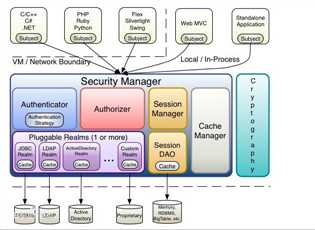标签:prope character write 并发 oge img 表单 配置文件 service
接下来做一下,用户的认证登陆以及权限验证,在这里使用shiro,首先来看一下shiro
Apache Shiro是一个强大且易用的Java安全框架,执行身份验证、授权、密码和会话管理。使用Shiro的易于理解的API,您可以快速、轻松地获得任何应用程序,从最小的移动应用程序到最大的网络和企业应用程序。

通过上图可以大概看出shiroe的架构,shiro的架构主要为:
认证的流程图大致如下

接下来,我们直接在项目中进行配置
首先在pom中引入需要的jar包,shiro1.5的使maven自动下载还不能下载,可以自己下载放到本地仓库,或者修改为1.4.2的
<!--第三方日志库--> <dependency> <groupId>commons-logging</groupId> <artifactId>commons-logging</artifactId> <version>1.2</version> </dependency> <!--Commons Collections增强了Java集合框架。 它提供了几个功能来简化收集处理。 它提供了许多新的接口,实现和实用程序--> <dependency> <groupId>commons-collections</groupId> <artifactId>commons-collections</artifactId> <version>3.2.2</version> </dependency> <!--shiro核心--> <dependency> <groupId>org.apache.shiro</groupId> <artifactId>shiro-core</artifactId> <version>${org.apache.shiro.version}</version> </dependency> <!--shiro整合web--> <dependency> <groupId>org.apache.shiro</groupId> <artifactId>shiro-web</artifactId> <version>${org.apache.shiro.version}</version> </dependency> <!--shiro应用缓存--> <dependency> <groupId>org.apache.shiro</groupId> <artifactId>shiro-ehcache</artifactId> <version>${org.apache.shiro.version}</version> </dependency> <!--整合spring-shiro--> <dependency> <groupId>org.apache.shiro</groupId> <artifactId>shiro-spring</artifactId> <version>${org.apache.shiro.version}</version> </dependency>
首先需要在web.xml中配置过滤器,帮助我们拦截请求
<!--配置shiro过滤器,拦截所有请求--> <filter> <filter-name>shiroFilter</filter-name> <filter-class>org.springframework.web.filter.DelegatingFilterProxy</filter-class> <init-param> <param-name>targetFilterLifecycle</param-name> <param-value>true</param-value> </init-param> </filter> <!--配置shiro的过滤路径--> <filter-mapping> <filter-name>shiroFilter</filter-name> <url-pattern>/*</url-pattern> </filter-mapping>
接下来配置application-shiro.xml文件
<?xml version="1.0" encoding="UTF-8"?> <beans xmlns="http://www.springframework.org/schema/beans" xmlns:xsi="http://www.w3.org/2001/XMLSchema-instance" xmlns:aop="http://www.springframework.org/schema/aop" xsi:schemaLocation="http://www.springframework.org/schema/beans http://www.springframework.org/schema/beans/spring-beans.xsd http://www.springframework.org/schema/aop https://www.springframework.org/schema/aop/spring-aop.xsd"> <!--配置realm数据源--> <bean id="employeeRealm" class="com.yang.web.realm.EmployeeRealm"> <property name="credentialsMatcher" ref="credentialsMatcher" /> </bean> <!--配置shiro过滤器--> <bean id="formFilter" class="com.yang.web.filter.FormFilter" /> <!--配置shiro安全管理器--> <bean id="securityManage" class="org.apache.shiro.web.mgt.DefaultWebSecurityManager"> <property name="realm" ref="employeeRealm" /> <!--配置缓存--> <property name="cacheManager" ref="ehCache" /> </bean> <!--使用第三方去扫描shiro的注解--> <bean class="org.apache.shiro.spring.security.interceptor.AuthorizationAttributeSourceAdvisor"> <property name="securityManager" ref="securityManage" /> </bean> <!--配置shiro过滤器--> <bean id="shiroFilter" class="org.apache.shiro.spring.web.ShiroFilterFactoryBean"> <!-- 配置登陆认证的路径 如果没有配置该路径,对于没有认证过的请求,会跳转到login.jsp 如果配置了该路径: 如果请求是loginUrl的路径,那就会去做认证 其他请求,会去执行对应login的请求 --> <property name="loginUrl" value="/login" /> <!--重新配置表单监听的过滤器--> <property name="filters"> <map> <entry key="authc" value-ref="formFilter" /> </map> </property> <property name="securityManager" ref="securityManage"/> <!--配置shiro的过滤器pattern--> <property name="filterChainDefinitions"> <value> /static/** = anon <!--不需要进行登陆验证--> /login.jsp = anon <!--不需要进行登陆验证--> /logout = logout <!--配置注销接口--> /** = authc <!--除了上述请求外,都需要进行登陆验证--> </value> </property> </bean> <!-- 配置代理 true:使用cglib的方式 false:使用jdk接口动态代理 --> <aop:config proxy-target-class="true" /> <!--凭证匹配器--> <bean id="credentialsMatcher" class="org.apache.shiro.authc.credential.HashedCredentialsMatcher"> <!--散列算法--> <property name="hashAlgorithmName" value="md5" /> <!--散列算法--> <property name="hashIterations" value="2" /> </bean> <!--缓存管理器--> <bean id="ehCache" class="org.apache.shiro.cache.ehcache.EhCacheManager"> <property name="cacheManagerConfigFile" value="classpath:shiro-ehcache.xml" /> </bean> </beans>
需要在springMvc的配置文件中导入这个包
<!--导入shiro的配置--> <import resource="classpath:application-shiro.xml" />
我们在配置shiro是,配置了缓存管理器,需要创建配置文件
<ehcache xmlns:xsi="http://www.w3.org/2001/XMLSchema-instance" xsi:noNamespaceSchemaLocation="http://ehcache.org/ehcache.xsd"> <defaultCache maxElementsInMemory="1000" maxElementsOnDisk="10000000" eternal="false" overflowToDisk="false" diskPersistent="false" timeToIdleSeconds="120" timeToLiveSeconds="120" diskExpiryThreadIntervalSeconds="120" memoryStoreEvictionPolicy="LRU"> </defaultCache> </ehcache>
我们在shiro中配置了loginUrl,因此需要在控制层实现对应的url
package com.yang.web; import org.springframework.stereotype.Controller; import org.springframework.web.bind.annotation.RequestMapping; /** * 配置了loginUrl,需要设置对应的函数 */ @Controller public class LoginController { @RequestMapping("/login") public String login() { return "redirect:login.jsp"; } }
接下来需要配置验证以及授权的realm
package com.yang.web.realm; import com.yang.domain.Employee; import com.yang.service.EmployeeService; import org.apache.shiro.authc.AuthenticationException; import org.apache.shiro.authc.AuthenticationInfo; import org.apache.shiro.authc.AuthenticationToken; import org.apache.shiro.authc.SimpleAuthenticationInfo; import org.apache.shiro.authz.AuthorizationInfo; import org.apache.shiro.authz.SimpleAuthorizationInfo; import org.apache.shiro.realm.AuthorizingRealm; import org.apache.shiro.subject.PrincipalCollection; import org.apache.shiro.util.ByteSource; import org.springframework.beans.factory.annotation.Autowired; import java.util.ArrayList; import java.util.List; /** * 设置员工权限realm,需要继承authorizingRealm */ public class EmployeeRealm extends AuthorizingRealm { /*注入*/ @Autowired private EmployeeService employeeService; /*认证*/ @Override protected AuthenticationInfo doGetAuthenticationInfo(AuthenticationToken token) throws AuthenticationException { System.out.println("认证,来啦"); // 获取身份信息 String username = (String) token.getPrincipal(); System.out.println(username); // 根据当前用户名查看当前是否存在当前用户 Employee employee = employeeService.getEmployeeByName(username); // 如果没有查询到employee、,就返回为空 if (employee == null) { return null; } // 进行认证 // 认证的参数,主体,正确的密码,盐,还有当前realm的名称 return new SimpleAuthenticationInfo(employee, employee.getPassword(), ByteSource.Util.bytes("!@#QAZwsx"), this.getName()); } /*授权*/ @Override protected AuthorizationInfo doGetAuthorizationInfo(PrincipalCollection principalCollection) { // 获取客户主体 Employee employee = (Employee) principalCollection.getPrimaryPrincipal(); // 声明角色集合 List<String> roles = null; // 声明权限集合 List<String> permissions = null; // 判断该角色是否是管理员 if (employee.getAdmin()) { // 是管理员,增加所有权限 permissions = new ArrayList<>(); roles = new ArrayList<>(); // 获取所有权限 permissions.add("*:*"); } else { // 查询该员工所拥有的角色集合 roles = employeeService.getRoleByEmployeeId(employee.getId()); // 查询该员工所有的权限集合 permissions = employeeService.getPermissionByEmployeeId(employee.getId()); } // 添加授权信息 SimpleAuthorizationInfo info = new SimpleAuthorizationInfo(); info.addRoles(roles); info.addStringPermissions(permissions); return info; } }
为了获取验证结果,我们需要配置form表单过滤器
package com.yang.web.filter; import com.fasterxml.jackson.databind.ObjectMapper; import com.yang.domain.AjaxRes; import org.apache.shiro.authc.AuthenticationException; import org.apache.shiro.authc.AuthenticationToken; import org.apache.shiro.authc.IncorrectCredentialsException; import org.apache.shiro.authc.UnknownAccountException; import org.apache.shiro.subject.Subject; import org.apache.shiro.web.filter.authc.FormAuthenticationFilter; import javax.servlet.ServletRequest; import javax.servlet.ServletResponse; import java.io.IOException; /** * 这个等登陆成功会调用,为了通知web,在这里面重写方法,重写表单监听的过滤器成功以及失败的方法 */ public class FormFilter extends FormAuthenticationFilter { /*当认证成功的时候,会进行调用*/ protected boolean onLoginSuccess(AuthenticationToken token, Subject subject, ServletRequest request, ServletResponse response) throws Exception { System.out.println(subject); // 因为回传信息包含中文,先设置字节码 response.setCharacterEncoding("utf-8"); AjaxRes ajaxRes = new AjaxRes(); ajaxRes.setSuccess(true); ajaxRes.setMsg("登陆成功!"); // 把对象转化为json字符串 String resString = new ObjectMapper().writeValueAsString(ajaxRes); // 将字符串写入响应对象 response.getWriter().print(resString); // return false 才会往下走,否则就组织了 return false; } /*当认证失败的时候,就会调用,e就是抛出异常*/ protected boolean onLoginFailure(AuthenticationToken token, AuthenticationException e, ServletRequest request, ServletResponse response) { // 设置响应数据 AjaxRes ajaxRes = new AjaxRes(); ajaxRes.setSuccess(false); if (e != null) { // 获取异常类的名称 String name = e.getClass().getName(); // 没有账号 if (name.equals(UnknownAccountException.class.getName())) { ajaxRes.setMsg("账号不正确"); } else if (name.equals(IncorrectCredentialsException.class.getName())) { ajaxRes.setMsg("密码不正确"); // 密码有误异常 } else { ajaxRes.setMsg("不确认错误"); // 其他错误 } } // 序列化返回结果并且放置到响应对象中 try { String resString = new ObjectMapper().writeValueAsString(ajaxRes); response.setCharacterEncoding("utf-8"); response.getWriter().print(resString); } catch (IOException ex) { ex.printStackTrace(); } System.out.println(ajaxRes.getMsg()); // return false 才会往下走,否则就阻止了 // return true; // 默认是返回true return false; } }
同时对于授权的使用,前端
<shiro:hasPermission name="employee:add"> <a href="#" class="easyui-linkbutton" data-options="iconCls:‘icon-add‘,plain:true" id="add">添加</a> </shiro:hasPermission>
后端
/*编辑员工*/ @RequestMapping("/employee/update") @ResponseBody @RequiresPermissions("employee:update") // 配置权限 public AjaxRes employeeUpdate(Employee employee){ return employeeService.updateEmployee(employee); }
为了处理异常,比如没有权限。一般在该类下写一个方法捕捉异常并处理
/* 设置异常处理 参数method就是发生异常的方法 */ @ExceptionHandler(AuthorizationException.class) public void handleShiroException(HandlerMethod method, HttpServletResponse response)throws Exception{ /*如果授权异常,则跳转授权页面*/ // 获取异常方法中的是否是json请求 ResponseBody methodAnnotation = method.getMethodAnnotation(ResponseBody.class); if(methodAnnotation != null){ // 这个就是ajax的请求 AjaxRes ajaxRes = new AjaxRes(); ajaxRes.setSuccess(false); ajaxRes.setMsg("没有权限操作"); String res = new ObjectMapper().writeValueAsString(ajaxRes); response.setCharacterEncoding("utf-8"); response.getWriter().print(res); }else{ response.sendRedirect("error-permission.jsp"); } }
标签:prope character write 并发 oge img 表单 配置文件 service
原文地址:https://www.cnblogs.com/yangshixiong/p/12307098.html